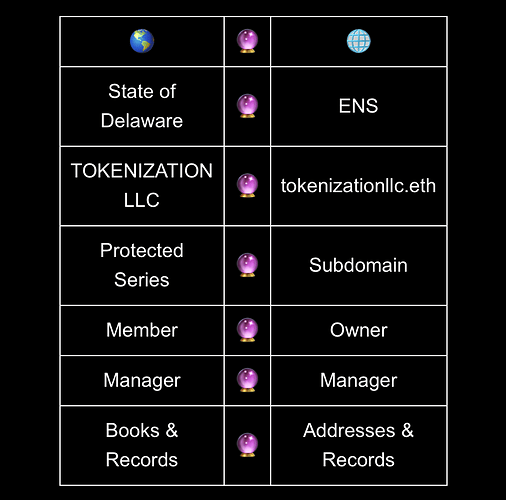TL;DR:
@arnold and I are taking lead on forming a group to develop a technical standard for storing organizational metadata on ENS. This will be formalized as a time-limited sub-group under one of ENS’s current working groups, tasked with producing an ENSIP and promoting adoption.
We are looking for feedback on this plan.
The Problem
DAOs have data that is important to share publicly, including things like:
- Addresses of DAO contracts and treasury wallets
- Delegates, their statements, conflicts of interest and other details
- Where proposal discussions and votes are taking place
- Off-chain organizational structure: working groups, stewards, committees, etc.
Currently, every DAO handles this differently, and these details are usually scattered between multiple web 2.0 locations (website, Github, Discourse, Tally, Agora, etc).
This makes it hard to know where to find information that is trustworthy and up-to-date. It also makes it impossible for dApps, smart contracts, and other services to programmatically retrieve this information in a trustless, web3 way.
This has been a known problem for a long time, with multiple attempts to solve it.
- ERC-4824 was proposed in 2022, and is still in draft status.
- In 2023, an on-chain “DAO Delegate Registry” was designed and launched, but now appears defunct.
- DAOStar published DAOIP-5 and DAOIP-7, and a report on DAO ID.
- In 2024, Arbitrum DAO voted 99% in favor of publishing this data on-chain, specifically as ENS text records. The plan appears to have never been implemented.
There is real demand for this problem to be solved, but so far no one has hunkered down and done it. ENS can change that.
The solution
We believe ENS is uniquely positioned to establish itself as the ecosystem’s central registry for this type of data. ENS is already the leader for individual identity, so extending this to also serve on-chain organisations is a natural extension.
We are in the process of producing a standard for how to store metadata as individual text records under ENS names/subnames, allowing for the creation of a federated knowledge graph for on-chain organizations.
Some standout benefits to doing it this way:
- ENS can become the single source of truth for on-chain information about DAOs and communities
- Records on ENS are credible, since they can only be updated by authorized entities
- Delegates and users can update their own records, decentralizing the flow of information
- The system is completely open and infinitely adaptable to new use cases
- No new functionality needs to be added to ENS; all that’s left is to agree on a standard
Overall, we believe this would be a great improvement to ENS, leading to more usage and adoption, and would become an invaluable service to the entire Ethereum ecosystem.
Progress so far
A draft spec has been started and is open for comments: DAO registry - HackMD
We have presented our work to the MetaGov, Ecosystem, and Public Goods working groups, to gather initial feedback and to gauge support for pursuing this idea.
The response has been very positive, with community members highlighting specific aspects of this idea they would like to see implemented.
Timeline
We are now in the process of figuring out where/how the sub-group (“pod”) should be established, after which the entire process should take no more than 6 months.
Stage I: Outreach (up to 3 months)
- We will engage with DAOs, vendors, and service providers to assemble representatives from across the ecosystem to participate
Stage II: Working sessions (up to 3 months)
- We will hold 6-8 working sessions, once every two weeks with async work in between, to finalize the standard
Deliverables
- Produce a formal ENSIP detailing the standard
- Produce a testnet implementation to demonstrate populating metadata, validating schemas, and retrieving schemas
How to get involved
For now, everything is being done in public and everyone is welcome to share their thoughts. Participation in working sessions will be dependent on an application process.
If you have any thoughts on this implementation plan please share them below, and if you would like to more actively participate, please join the project’s Telegram group: Telegram: Join Group Chat
